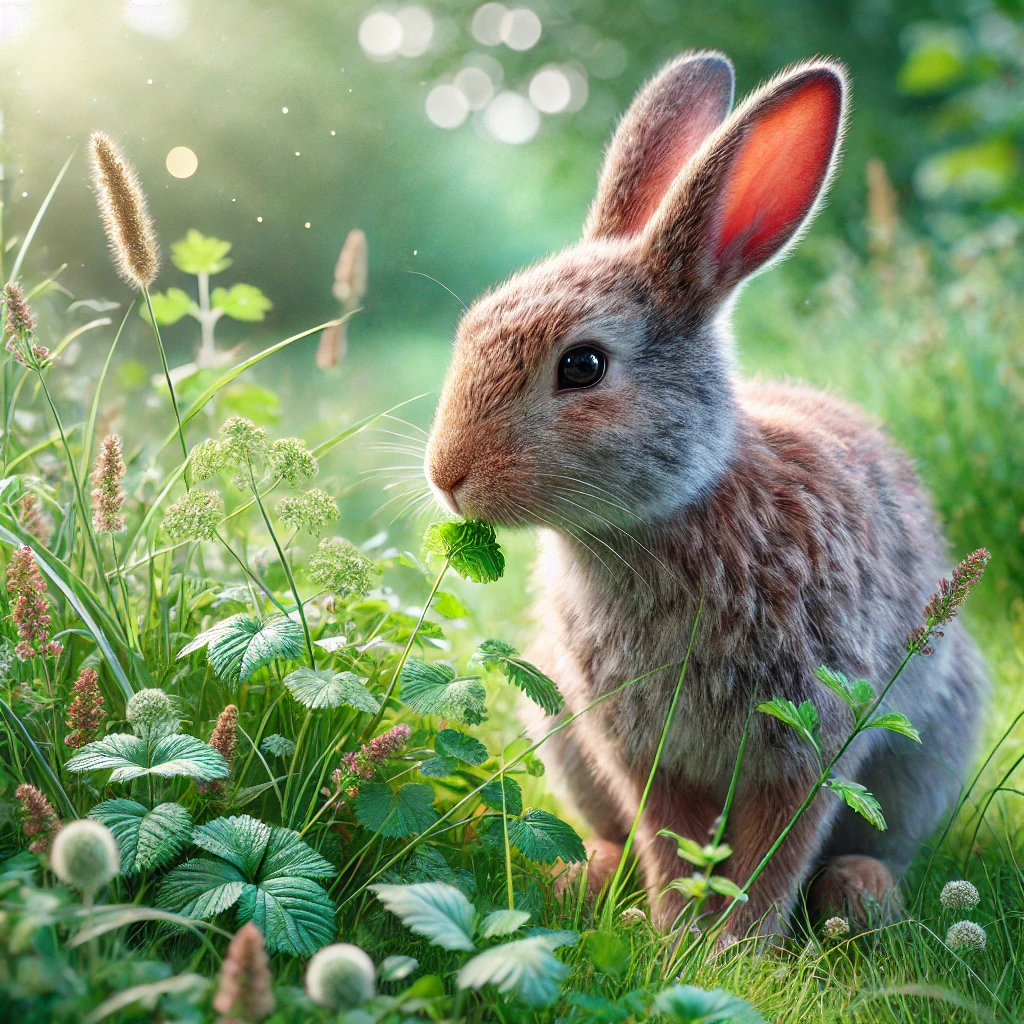What Do Wild Rabbits Eat?
Wild rabbits are common in many natural and suburban areas across Canada, recognized for their soft fur, quick movements, and twitching noses. Their diet plays a vital role in keeping them healthy, helping them evade predators, and contributing to a balanced ecosystem. In this guide, we explore what wild rabbits eat, how their diet changes by season, and their influence on their natural habitats.
1. The Basic Diet of Wild Rabbits: Herbivores with a Taste for Variety
Wild rabbits are strict herbivores, feeding on various plants, including grasses, leafy greens, and fruits. Their plant-based diet keeps them healthy and enables them to thrive in different environments.
- Grasses: Grass is a staple food for wild rabbits, providing essential fiber that aids in digestion. Rabbits graze on grasses throughout the year, particularly when other food sources are scarce.
- Herbs and Weeds: Wild rabbits consume a variety of herbs and weeds, including clover, dandelions, plantain, and thistles. These plants are nutrient-rich and help provide a balanced diet.
- Fruits and Vegetables (Seasonal): In seasons when fruits and vegetables are available, wild rabbits may eat berries, apples, carrots, and other accessible crops. They enjoy the sweetness and moisture that fruits provide, though they consume them sparingly.
- Bark and Twigs: During the winter, wild rabbits often rely on bark, twigs, and buds from shrubs and trees, as fresh greenery becomes scarce. This roughage provides nutrients and fiber needed for survival during colder months.
By feeding on this variety, wild rabbits meet their nutritional needs and stay active and alert, which is crucial for avoiding predators.
2. Seasonal Diet Changes
Wild rabbits adapt their diet based on the availability of food in each season. Here’s how their diet shifts throughout the year:
- Spring and Summer: In warmer months, wild rabbits primarily feed on fresh grasses, leafy plants, and young shoots. These foods provide high levels of vitamins and nutrients, which support growth and energy.
- Fall: As autumn arrives, rabbits start to consume more roots, bulbs, and bark, preparing for the leaner winter months. They may also eat fallen fruits and berries to build up energy.
- Winter: In winter, wild rabbits rely on woody plants, such as twigs, bark, and evergreen needles, when other plants become scarce. These foods are harder to digest but help wild rabbits survive when little else is available.
This seasonal adaptation helps wild rabbits survive year-round, even in challenging conditions.
3. How Wild Rabbits Find Food
Wild rabbits rely on their keen senses and instinctive behaviors to locate food sources. Here’s how they forage in the wild:
- Keen Sense of Smell: Wild rabbits have an excellent sense of smell that helps them locate plants and detect potential threats. They use their noses to identify fresh food sources, especially hidden herbs or roots.
- Foraging Patterns: Wild rabbits typically forage early in the morning and late in the evening, taking advantage of lower light to avoid predators. This pattern allows them to find food while staying safe.
- Grazing Behavior: Rabbits are grazers, meaning they prefer to nibble on plants throughout the day. This behavior allows them to stay alert to potential threats and digest food in small portions.
Foraging plays an essential role in keeping wild rabbits healthy, ensuring they consume the diverse foods they need.
4. Nutritional Needs of Wild Rabbits
Wild rabbits need a high-fiber, low-fat diet to maintain their digestive health. Their diet meets these nutritional needs in various ways:
- Fiber for Digestion: Grass and hay provide the fiber rabbits need for proper digestion. Fiber prevents blockages in the digestive tract, allowing food to pass smoothly.
- Hydration from Vegetation: Rabbits obtain much of their hydration from plants, especially succulent greens, which are high in moisture. This helps them stay hydrated, particularly in dry seasons.
- Protein from Young Plants: Young plants and herbs provide moderate protein, supporting muscle development and growth. Wild rabbits find these foods during the growing season, which helps them stay active.
A balanced diet supports rabbits’ health, giving them the energy they need to forage, reproduce, and evade predators.
5. Wild Rabbits’ Role in the Ecosystem
Wild rabbits impact their environment in several ways, from spreading seeds to providing food for predators. Here’s how they contribute to ecosystem health:
- Seed Dispersal: By eating fruits and plants, rabbits inadvertently disperse seeds through their droppings, supporting plant regeneration and biodiversity.
- Vegetation Control: Rabbits’ grazing prevents overgrowth in fields, meadows, and forest edges. This control helps maintain open areas and supports other herbivores who rely on similar food sources.
- Food Source for Predators: Wild rabbits are a primary food source for many predators, including foxes, hawks, owls, and coyotes. Their presence supports the food web, providing energy for carnivorous species.
These ecological roles make wild rabbits an essential part of their habitats, supporting biodiversity and environmental balance.
6. Preventing Wild Rabbits from Damaging Gardens
While wild rabbits are beneficial to ecosystems, they can sometimes become a nuisance to gardeners. Here are some humane ways to prevent wild rabbits from damaging plants:
- Fencing: Install fencing around gardens, with mesh no larger than 1 inch and at least 2 feet high. Bury the bottom edge several inches deep to prevent rabbits from burrowing underneath.
- Rabbit-Repellent Plants: Plant strong-smelling herbs like rosemary, lavender, or marigolds, which rabbits tend to avoid. Surrounding your garden with these plants may deter rabbits.
- Natural Repellents: Sprinkle substances like crushed red pepper or garlic powder around plants. These smells discourage rabbits from nibbling on garden vegetables and flowers.
- Remove Attractants: Keep gardens free of fallen fruit, vegetable scraps, and accessible compost, which can attract rabbits to your yard.
These methods help protect your garden while allowing wild rabbits to thrive in nearby natural spaces.
Frequently Asked Questions About Wild Rabbits’ Diet
- Do wild rabbits eat meat?
No, wild rabbits are strict herbivores and do not eat meat. They rely on plant-based foods exclusively for their nutrition. - Can wild rabbits eat vegetables from my garden?
Yes, wild rabbits may eat vegetables such as carrots, lettuce, and peas if they find them in gardens. They are opportunistic feeders when food is available. - What do wild rabbits eat in winter?
During winter, wild rabbits rely on twigs, bark, and evergreen plants to survive. They adapt to the scarcity of food by consuming these woody plants.
Conclusion
Wild rabbits survive and thrive by eating a diverse range of plants, grasses, and seasonal foods. Their diet changes with the seasons, allowing them to meet their nutritional needs and support their active lifestyles. Wild rabbits also play crucial roles in their ecosystems, from seed dispersal to vegetation control. By understanding what wild rabbits eat, we can better appreciate their adaptability and ecological importance.






